Nestled in the North Atlantic, Iceland is a land of contrasts and wonders, renowned for its dramatic landscapes, geothermal wonders, and captivating culture. From cascading waterfalls and steaming hot springs to the mesmerising dance of the Northern Lights, Iceland’s natural beauty is truly breathtaking. Yet, amidst its myriad attractions, Icelandic cuisine often takes a backseat in the global culinary scene. While the country may not be top of mind for its food, it’s a hidden gem waiting to be discovered by adventurous foodies and curious travellers alike.
Despite its humble culinary reputation, Iceland’s gastronomic landscape is a delightful blend of tradition and innovation, offering a feast for the senses that’s as unique and unforgettable as the country itself. For those willing to venture beyond the beaten path, Iceland’s culinary treasures await, promising a culinary journey like no other.
Iceland’s food is a reflection of its history, geography, and culture. In this guide, we’ll delve into the delicious, interesting and sometimes strange world of Icelandic cuisine, from traditional favourites to more modern options. So, grab your appetite and let’s explore the best food Iceland has to offer!
A Brief History of Food in Iceland

Iceland’s culinary journey is as rich as its volcanic soil. Historically, Icelandic cuisine has been shaped by its harsh climate and limited agricultural resources.
Picture this: over a millennium ago, Viking settlers sailed into what seemed like a land of plenty. Lush birch forests greeted them, promising endless resources. But as they began to build and settle, reality hit hard. Icelandic birch, it turned out, was in no hurry to grow back. Volcanic soil and endless winters weren’t exactly conducive to agriculture either.
Starvation became a familiar spectre, looming over the early settlers like a relentless foe. Population numbers plummeted time and again, decimated by hunger, disease, and nature’s fury. Food wasn’t just scarce; it was a luxury, a distant dream in a harsh landscape.
Early settlers relied heavily on fishing, hunting, and dairy farming for sustenance. Traditional preservation methods like drying, smoking, and fermenting were essential for survival during the long, cold winters.
Then, after the tumultuous time of World War II, winds of change blew in with foreign troops. Alongside them came a taste of the unfamiliar, a glimpse of a world beyond survival. The Icelandic palate expanded, embracing new flavours, new possibilities. Fish and dairy, the old staples, made room for a colourful array of vegetables and international delights.
Fast forward to today, and Iceland stands at the crossroads of tradition and innovation. Greenhouses dot the landscape, nurturing a bounty of fresh produce year-round. The modern Icelander savours a fusion of old and new, a testament to resilience and adaptability.
In Iceland, every meal tells a story; a saga of survival, of resilience, and of the enduring spirit that thrives against all odds.
What Main Produce Does Iceland Traditionally Use in Cooking?
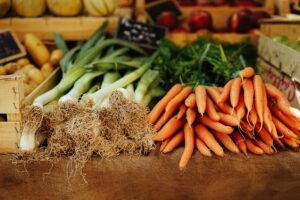
Despite its challenging environment, Iceland boasts an abundance of fresh, high-quality produce, nourished by the island’s unique natural resources and innovative agricultural practices. The pristine waters surrounding Iceland are home to an astonishing variety of fish, including cod, haddock, salmon, and trout, which thrive in the nutrient-rich North Atlantic currents.
These sustainably harvested fish not only provide a vital source of protein but also serve as the cornerstone of Icelandic cuisine. From flaky cod to succulent salmon, seafood takes centre stage on Icelandic dinner tables, celebrated for its unrivalled freshness and exquisite flavour profiles.
On land, Icelandic lamb reigns supreme, prized for its exceptional tenderness and rich, distinctive taste. Raised in free-range conditions, Icelandic sheep graze on nutrient-dense pastures, resulting in meat that’s lean, flavourful, and ethically sourced. Whether slow-roasted to perfection or grilled over an open flame, lamb dishes showcase the natural bounty of Iceland’s rugged landscape, offering a taste of tradition with every savoury bite.
In addition to seafood and lamb, dairy products play a pivotal role in Icelandic cuisine, contributing to its creamy textures and indulgent desserts. Icelandic skyr, a cultured dairy product similar to yoghourt, has been a dietary staple for centuries, revered for its high protein content and smooth, velvety consistency.
To complement its protein-rich offerings, Icelandic cuisine also embraces hearty grains like barley and rye, which have been cultivated on the island for centuries. These ancient grains lend depth and complexity to traditional dishes like rúgbrauð, (rye bread) and pönnukökur, (pancakes), serving as a comforting backdrop for the bold flavours of Icelandic fare.
With its commitment to sustainable farming practices and a deep respect for the land and sea, Iceland continues to cultivate a culinary legacy that’s as rich and diverse as its natural landscapes. From the depths of the ocean to the lush green meadows, Icelandic cuisine reflects the resilience, ingenuity, and indomitable spirit of its people, inviting visitors to embark on a gastronomic adventure unlike any other.
Uncovering the Top 21 Icelandic Food Favourites

There are many different food favourites enjoyed in Iceland and the scope of what the locals like to eat does evolve much like elsewhere in the world. However, there are some absolute favourites that anyone interested in learning about Icelandic cuisine should know and should certainly try if they decide to visit here. So without any more waiting, it’s time to grab our cutlery and dig in.
1. Icelandic Hotdogs (Pylsur)

A staple of Icelandic street food culture, pylsur is more than just your average hotdog. Made from a blend of lamb, pork, and beef, topped with crunchy onions, ketchup, and a sweet brown mustard, these hotdogs pack a flavourful punch. Don’t leave Iceland without trying one.. or two!
One of Iceland’s most famous hot dog stands is Bæjarins Beztu Pylsur, located in Reykjavik. This humble food cart has gained international fame for serving up mouthwatering hot dogs since 1937. What sets Bæjarins Beztu Pylsur apart is its simple yet irresistible recipe; grilled lamb sausages topped with a medley of condiments including ketchup, sweet mustard, remoulade, raw onions, and crispy fried onions.
Locals and tourists alike flock to this iconic stand to indulge in its savoury delights, making it a must-visit destination for anyone craving a taste of Icelandic street food culture. So, if you’re looking to experience a true Icelandic culinary tradition, be sure to swing by Bæjarins Beztu Pylsur and savour the flavours of Reykjavik’s most famous hot dogs.
2. Kjötsúpa (Meat Soup)
Perfect for warming up on a chilly Icelandic day, kjötsúpa is a hearty meat soup made with tender lamb, root vegetables, and barley. Simmered to perfection, this soul-soothing dish is a comforting hug in a bowl.
3. Fish and Chips

Iceland puts its own spin on this British classic by using locally caught fish, typically cod or haddock, coated in a crispy batter made with Icelandic beer. Served with chunky fries and tartar sauce, it’s a taste sensation that will leave you craving more.
4. Plokkfiskur
This traditional Icelandic fish stew features flaky white fish, potatoes, onions, and béchamel sauce, all baked to golden perfection. Plokkfiskur is the epitome of comfort food, guaranteed to warm both body and soul.
5. Harðfiskur (Dried Fish)
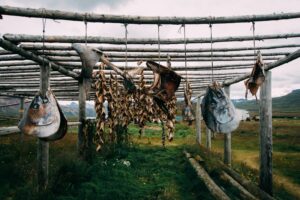
A beloved Icelandic snack, harðfiskur is dried fish jerky with a chewy texture and a salty-sweet flavour. Packed with protein and omega-3 fatty acids, it’s the perfect on-the-go treat for outdoor adventures.
6. Humarsúpa (Lobster Soup)
Indulge in the luxurious flavours of Icelandic lobster with this creamy, velvety soup. Made with tender chunks of lobster meat, vegetables, and a hint of cream, humarsúpa is a decadent delight that embodies Icelandic seaside dining.
7. Rúgbrauð (Rye Bread)
No Icelandic meal is complete without a slice of rúgbrauð, dense and dark rye bread baked in geothermal ovens. Its distinctive earthy flavour pairs perfectly with butter or smoked fish, making it a versatile and essential part of Icelandic cuisine.
8. Lambakjöt (Roast Lamb)
Icelandic lamb is renowned for its exceptional quality and flavour, thanks to the country’s pristine pastures and sustainable farming practices. Whether roasted with herbs and garlic or slow-cooked until tender, lambakjöt is a culinary delight not to be missed.
9. Lightly Salted Cod
As a nation surrounded by the North Atlantic Ocean, Iceland has a deep-rooted love affair with cod. Lightly salted and served with buttery potatoes and a squeeze of lemon, this simple yet elegant dish showcases the natural flavours of Icelandic seafood.
10. Rainbow Trout
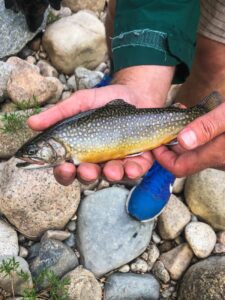
Freshwater fishing is a popular pastime in Iceland, and rainbow trout is a local favourite. Grilled or pan-seared to perfection, this delicate fish pairs beautifully with seasonal vegetables for a light and satisfying meal.
11. Skyr
Skyr is a creamy, thick yoghurt-like dairy product, skyr has been a dietary staple in Iceland for centuries. High in protein and low in fat, it’s enjoyed plain or flavoured with fruit and honey, making it a nutritious and delicious snack or dessert.
12. Rjúpa (Ptarmigan)
For adventurous foodies seeking a taste of Icelandic game meat, rjúpa, or ptarmigan, is a must-try. This small game bird is typically roasted or braised and served with wild berries or a rich sauce for a truly unique dining experience.
13. Lifrarpylsa (Liver Sausage)
A traditional Icelandic delicacy, lifrarpylsa is a hearty sausage made from a blend of lamb’s liver, suet, oats, and spices. Sliced and served cold or fried until crispy, it’s a rich and flavourful treat that pairs well with rye bread and pickles.
14. Gravlax
Elevate your seafood experience with gravlax, a Scandinavian specialty that’s beloved in Iceland. Thinly sliced salmon, cured with a blend of salt, sugar, and dill, gravlax boasts a delicate texture and a melt-in-your-mouth flavour that’s simply irresistible.
15. Blóðmör
Brave souls seeking a taste of traditional Icelandic cuisine won’t want to miss blóðmör, or blood pudding. Made from a mixture of sheep’s blood, oatmeal, and spices, then boiled in sheep’s intestines, it’s an acquired taste that’s not for the faint of heart.
16. Kleina
Satisfy your sweet tooth with kleina, a traditional Icelandic pastry similar to a doughnut. Deep-fried until golden and crispy, then dusted with powdered sugar, kleina is a delightful indulgence enjoyed with a cup of coffee or hot chocolate.
17. Rúllupylsa (Rolled Sausage)
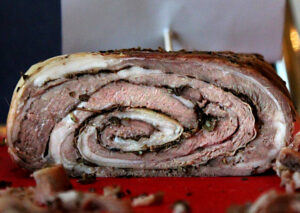
Rúllupylsa is a festive dish often served during holidays and special occasions in Iceland. Made from spiced lamb or pork, rolled up and cooked until golden brown, it’s a savoury delight that’s perfect for sharing with family and friends.
18. Pönnukökur (Pancakes)
Icelandic pancakes, or pönnukökur, are thinner and smaller than their American counterparts but equally delicious. Served with jam, whipped cream, or chocolate spread, these light and fluffy pancakes are a favourite treat for breakfast or dessert.
19. Hangikjöt
Embrace the smoky flavours of Icelandic cuisine with hangikjöt, or smoked lamb. Traditionally served cold and thinly sliced, this tender and flavourful meat is a beloved part of Icelandic holiday feasts and celebrations.
20. Ice Cream

Despite its chilly climate, Icelanders have a passion for ice cream, and it’s not hard to see why. Made with fresh Icelandic dairy and creative flavour combinations like licorice, rhubarb, and sea salt caramel, Icelandic ice cream is a cool and creamy delight that’s sure to please.
What Weird Foods Do They Eat in Iceland?

While Iceland is renowned for its culinary delights, it’s also home to some more unusual delicacies that might raise an eyebrow or two.
21. Svið (Sheep’s Head)
A true Icelandic delicacy, svið is a sheep’s head that’s been singed, boiled, and served whole or halved. Despite its intimidating appearance, svið is cherished for its tender meat and rich flavour, making it a favourite at traditional Icelandic feasts.
22. Slátur (Icelandic Black Pudding)
Made from a mixture of sheep’s blood, fat, and oatmeal, slátur is a type of black pudding that’s boiled in sheep’s intestines and served as a savoury sausage. It’s an acquired taste that’s beloved by some and avoided by others.
23. Hrútspungar (Ram Testicles)
For the truly adventurous, hrútspungar, or ram testicles, are a delicacy worth trying. These tender morsels are boiled, pressed, and pickled, resulting in a unique texture and flavour that’s not for the faint of heart.
24. Hákarl (Fermented Shark)
Hákarl is perhaps Iceland’s most infamous culinary curiosity. Made from shark that’s been buried underground and fermented for several months, hákarl has a pungent ammonia smell and a strong, acquired taste that divides opinion among locals and visitors alike.
Icelanders ferment the shark before eating it primarily to make the meat safe and palatable. The species of shark commonly used for this dish, the Greenland shark, contains high levels of urea and trimethylamine oxide, which are byproducts of its metabolism. These compounds make the raw flesh toxic and inedible to humans.
The fermentation process, known as “þorramatur,” involves burying the shark meat in sand or gravel for several weeks to several months. During this time, the meat undergoes a natural fermentation process facilitated by enzymes and bacteria present in the shark’s tissues. This process breaks down the urea and trimethylamine oxide into less harmful compounds, rendering the meat safe to eat.
Additionally, the fermentation process imparts a distinctive flavour and aroma to the shark meat, giving it a strong, pungent taste that is an acquired taste for many. Despite its challenging flavour profile, hákarl holds cultural significance in Iceland and is often enjoyed as part of traditional celebrations and feasts.
25. Skate
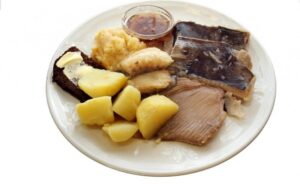
Skate, a type of flatfish, is another Icelandic delicacy that’s not for the faint of heart. Its strong, ammonia-like flavour and gelatinous texture make it an acquired taste that’s enjoyed by some but reviled by others.
Icelanders traditionally eat skate during the winter months, particularly during the midwinter festival known as “Þorrablót.”
The consumption of skate during Þorrablót is rooted in historical necessity. In centuries past, Iceland’s harsh winters made fresh food scarce, and preserving food through methods like fermentation and drying was essential for survival. Skate, with its tough, gelatinous texture and strong ammonia-like flavour, was one of the few available sources of protein during the winter months.
Be warned though, if you happen to be out in Reykjavík during this festival, you might need to invest in some dry-cleaning. The scent of Skate has a tendency to stick to clothing.
Conclusion

Icelandic cuisine is a reflection of the country’s unique history, geography, and culture, with a diverse array of dishes to tantalise your taste buds. Whether you’re savouring traditional favourites like Icelandic hotdogs and fish soup or exploring more adventurous options like fermented shark and ram testicles, Iceland offers a culinary experience like no other. So, embrace your inner foodie, and let your taste buds embark on a delicious journey through the land of fire and ice!

